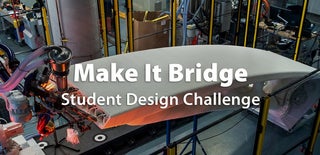Introduction: Combs Bridge 2023
Hearing about this competition caused a spark in me, one I had gotten in other previous ACE Competitions. Personally, I have always been competitive and enjoyed a good challenge. Once the opportunity to compete in another challenge was presented to me, I was ecstatic. Previously competing in ACE Competitions thru my school, Hodgson Vo-Tech High School, I was moderately prepared for this journey ahead. After learning it was a Bridge Competition, I became even more excited. I knew previously that my family owned a bridge out in Virginia. Thru this challenge I got to explore more about my own family's history.
Supplies
I used mostly Google, my family's history books, and Revit. To create and design my project.
Step 1: Finding Bridge Location
I discovered history about my family, I may have never looked into. Learning that my family owned a bridge, pieces of land, and helped build churches in Marion, Virginia. The land we owned is (as far as I know) named after my great- great- grandparents who lived and worked in the town. They were William (Bill) Thomas and Virginia M. (Virgie) Thomas, giving the now road the name; Thomas Bridge Road. The information I had been told previously, had proven false in my discoveries, my grandfather believed the bridge no longer existed, however, I have found the bridge, at the very south end of the road. So, for this project I choose to bring more life to the existing bridge.
Step 2: Inspiration
Once I figured out the location of my project, I began looking into different models of bridges and deciding which I wanted to implement into my designs. I was intrigued by Truss Bridges and their design implications. Once I made this discovery, I proceeded to begin sketches.
Step 3: Thought Process
Surrounding the bridge is a body of water and other small shops. Even though I've never personally been there, this road appears as though it is a backroad citizens may walk on or fish nearby. Due to this, I wanted to provide an area in my design so that civilians could safely fish or walk across the bridge if need be. Also, in my findings, I noticed there are trees surrounding overhead. In this discovery I decided I wanted to include a barrier above, in precaution if there is a storm that causes leaves and branches to break of fall and damage the bridge.
Step 4: Finding Information and Detailing
After deciding to proceed with Truss Bridges and including the components I wanted to, I jumped right into finding out research about certain requirements and limitations bridges of my design needed or had to include. I knew I needed to include another support for the additional weight and certain requirements needed to be met for the sidewalk and overhead.
Step 5: Sketches
In my personal notebooks, I began putting onto paper the ideals I wanted included and how I wanted them to be included. I wrote down the ideas and thoughts going through my head about how to approach this project. I began designing the way I wanted the Trusses to lay and how I wanted them to look.
Step 6: Creating the Existing Structure
Firstly, I began taking a screenshot of the top view of the Bridge on Google Maps. Then proceeded to scale it on Revit. Doing this to make sure the dimensions were properly portrayed when creating the structure. After it was scaled, I then designed the existing structure. In Revit, I used different floor materials and placed them in the most accurate positions. The materials included grass, concrete, pavement, and water. The bridge itself isn't large, it's measurements are 100' - 0'' by 29' - 0'' with a -5° curve.
Step 7: Creating Sidewalk
Launching into my adaptation of the project I started with creating the sidewalk and deciding how far out I wanted to extend the bridge to allow for the sidewalk. I decided on extending the road 6' - 0". 5' - 0" of that being sidewalk and the other 12" to be used for handrails and barriers between the road and sidewalk. Then I readded the bridge onto the existing foundation and proceeded to extend the sidewalk out farther past the bridge to allow better safety opportunities for pedestrians.
Step 8: Creating Overhead
Once I added the sidewalk onto my bridge design, I then undertook adding the overhead and Tuss aspect of the bridge. In this I researched the height requirements for overheads and began designing it in my chose of style. I choose the "N" shaping of the Tusses because of the support and visual aspect of it. In creating the Overhead, I wanted a pointed slant for rain purposes. It is large enough to cover the sidewalk so if pedestrians could be covered in the events of different weather conditions.
Step 9: Conclusion
Finally, with all these components together I refurbished a bridge that led me to discovering more details about my own history and allowed me to explore more education in Civil Engineering and Architecture.

Participated in the
Make It Bridge









